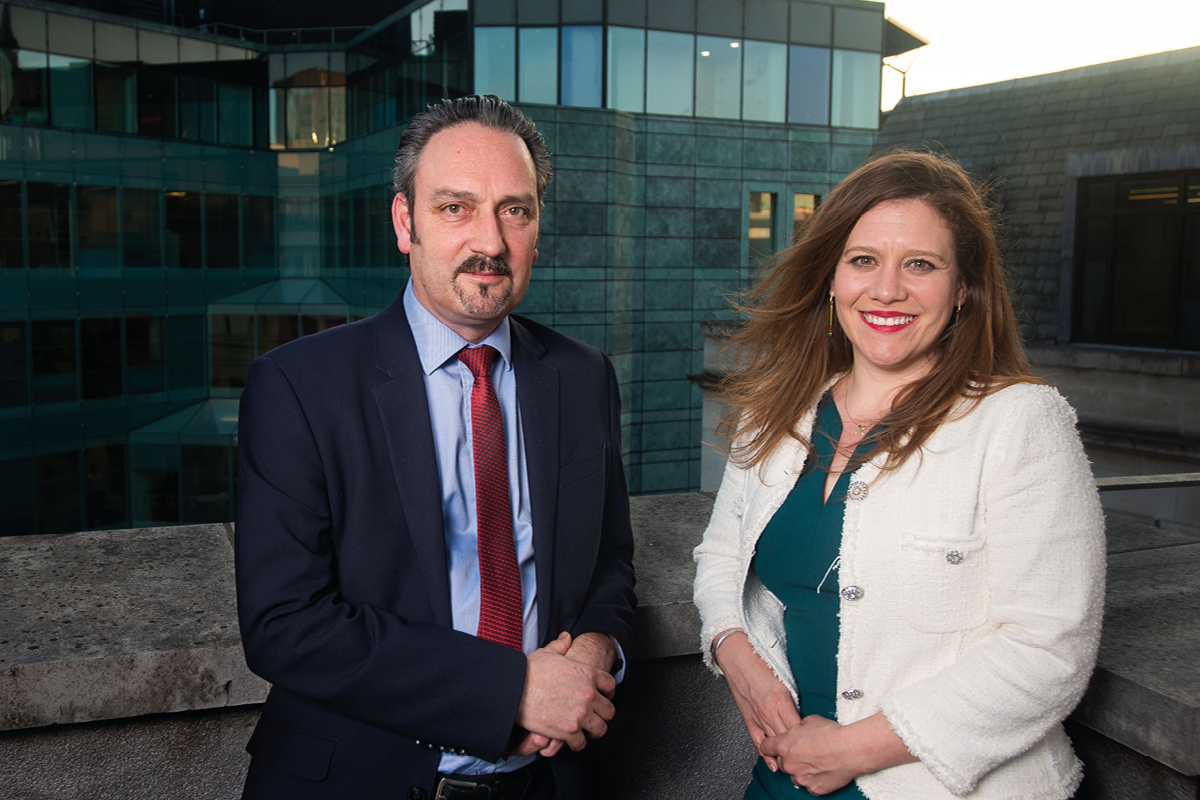You are viewing 1 of your 1 free articles
City slickers: a look at Places for People’s fund management arm
When Places for People launched a fund management arm two years ago, eyebrows may have been raised. But could this unusual move help address the housing shortage? Gavriel Hollander meets two of the company’s leading lights to find out. Photography by Simon Brandon
Chris Jones, director, PfP Capital and Alex Notay, director of PfP Capital’s build-to-rent fund
Places for People (PfP) has often been viewed by its housing association peers as something of an enigma.
It owns and manages more than 180,000 homes and has a UK-wide geographic footprint, yet describes itself on its website as “a placemaking and regeneration company” rather than a social landlord or housing association.
The group’s many and varied subsidiaries include a leisure centre management company, retirement living specialists, and a facilities management business.
But perhaps PfP’s most eyebrow-raising move in recent times was the launch in 2017 of its own fund management arm.
Two years on, Inside Housing has come to PfP’s office in the heart of the City to find out precisely what a housing association is doing dipping its toe into the financial services waters – and to discover what progress it has made so far.
First thing’s first, let’s address the elephant in the room: the ‘c’ word.
“I find it frustrating when ‘commercial’ is used as a pejorative term,” says Alex Notay, director of PfP Capital’s build-to-rent fund, who’s quick to upbraid Inside Housing for using the word to question whether having investors that require certain returns creates a different dynamic.
It’s clearly a favourite subject for Ms Notay, a former consultant who was initially brought into PfP by group chief executive David Cowans to be its director of product and service innovation.
“I’m glad we are commercial. It’s about having to be responsible for the money you raise and spend. But we’re not driven by shareholder returns, so we can take decisions that people who have to deliver to shareholders can’t.”
She believes there is a false dichotomy in the housing sector between landlords’ commercial activities, which produce a profit, and their social housing activities, which are depicted as needing to be propped up by subsidies.
“Everyone is so keen to put people into binary opposition,” she continues. “People tend to assume that the social housing elements of a business are less efficient, but it’s one of the best-run businesses I’ve seen. They are incredibly efficient – they’ve had to be.”
The fund that Ms Notay runs is the largest of the three PfP Capital has so far set up. The build-to-rent fund is targeting £550m of capital from institutional investors to fund the building of 3,000 homes.
There is also a £330m PRS fund, which attracted a £300m investment from the Universities Superannuation Scheme (USS) pension fund, a Scottish government-supported mid-market rent fund, and the Igloo regeneration fund, which PfP bought last year.
Between them, the four funds are worth around £1bn and expect to deliver some 8,000 homes through an initial three-year phase.
For managing director Chris Jones, the establishment of PfP Capital is just the next logical step in the group’s financing journey.
Chris Jones, director, PfP Capital
“PfP has for a long time been an innovator in raising capital,” he says. Mr Jones joined PfP’s treasury team in 1993, the year of its first bond issue. Thirteen years later, it launched its groundbreaking medium-term note programme, which allowed it to borrow on an unsecured basis.
Since then, PfP has raised money on the bond markets in Europe, Asia and the US. But according to Mr Jones, there was only so far the group could go by increasing its debt pile.
“The next logical step for me was to look at equity and how we could bring it into the group,” he explains. “We recognise there’s an enormous challenge in the housing sector and there’s only so much work we can do to meet that by bringing in investment on the group’s balance sheet in debt form. By setting up a fund management business and bringing in capital across a range of funds, we’re looking to increase the group’s capacity to deliver more across housing – social, affordable, PRS and build to rent. It’s placemaking.”
“I find it frustrating when ‘commercial’ is used as a pejorative term” – Alex Notay
Mr Jones and Ms Notay are chalk and cheese as a double act. While he brings 25 years’ experience in the same organisation, she has the energy of a disruptor, looking to shake up the traditional way of doing things.
Ms Notay leans forward and talks at a brisk pace and with obvious passion, while her boss sits back in his chair and exudes calm, his voice almost impossible for the dictaphone recording the conversation to pick up.
But both are equally keen that the project they are working on is not misunderstood. They insist it is about bringing “additionality” to Places for People and the sector as a whole.
“Build to rent is inherently about additionality,” echoes Ms Notay, explaining that she believes it is not a tenure a housing association could do on its own balance sheet. “That’s because by nature it’s much larger scale and there’s a bigger lag. That’s something that can only work with institutional equity.”
Since taking on her role, Ms Notay has been a regular presence at housing conferences, extolling the virtues of build to rent to a sometimes sceptical housing association audience. “There’s an awful lot of questions but no aggressive challenges,” she insists.
Alex Notay, director of PfP Capital’s build-to-rent fund
A busy life obviously suits her – on the day Inside Housing meets her, she woke up at 4am to catch a pre-dawn train from her Bristol home to take part in a round table discussion on trust and diversity in the property industry.
But despite the early start, her passion is obvious. She is particularly keen to dispel the idea that organisations such as PfP are less focused on their social purpose, simply because they conjure innovative ways to raise money and deliver a broad range of tenures.
She references Larry Fink, the chief executive of US investment management giant Blackrock, and his open letter to business leaders in January. “He was saying: it’s not enough to deliver shareholder return, now we have to deliver social impact.
“We come at it from the other angle. We have a team of six who work on social value, a social value dashboard and metrics coming out of our ears. If we can bring those placemaking values to all our funds then that’s much stronger.”
Neither Ms Notay nor Mr Jones will be drawn on what kind of returns they offer investors. But the latter agrees that for those investing in PfP Capital’s funds, the bottom line isn’t everything.
“Our platform offers investors the opportunity to invest in a business that creates social value. It’s not just bricks and mortar, but it’s creating communities, employment and local businesses. We look at it from a placemaking perspective and we work up from that.”
For some time, attracting institutional investment at scale has been the white whale of the housing sector. The early signs suggest that PfP Capital could finally be landing it and that this type of investor could help deliver housing across the tenure mix.
The other elusive beast has been build to rent, a tenure that was thrust into the limelight by the 2012 Montague Review. Ms Notay accepts that it has so far been concentrated on “urban in-fill” sites in major cities, but she is trying to change that.
Chris Jones (left) and Alex Notay say equity is needed to fund housebuilding
“I feel like Kevin Costner in that baseball film,” she jokes. “‘If you build it, they will come.’ But there’s only so many times you can say, ‘Trust me, it’s a completely different tenure type and financial model but give me however many tens of millions to build it.’ You’re driven by what the market will accept and where the market was confident was London.”
Market confidence may also be lower than ideal because of the wider political climate. “Brexit is a handful for people taking decisions,” sighs Ms Notay when asked about how long it might take for her fund to reach its target. “We’ve got significant appetite from investors and some great schemes lined up but in the current environment, things are taking longer.”
In the longer term, however, the signs for build to rent are positive and a vehicle such as PfP Capital’s fund can be the catalyst to push it into the mainstream. Why?
Because housing associations using on-balance borrowing simply won’t stack up, Mr Jones says: “The issue for housing associations is that the scale of investment in one building is huge and that probably sits outside the risk profile that they’re prepared to take.
“Part of the rationale in setting up a build-to-rent platform is that we can engage with delivering build-to-rent products without exposing the Places for People group to any risk.”
Ms Notay is keen to point out that build to rent is not seen as affordable – with the usual ‘air quotes’ that accompany the word – but as something that gives renters greater choice.
“Our tag is to try to go for aspirational but achievable,” she says. “I get frustrated with articles that call it a silver bullet, because if I had a pound for every time someone said that, I’d have a huge fund already. We need more of everything.”













